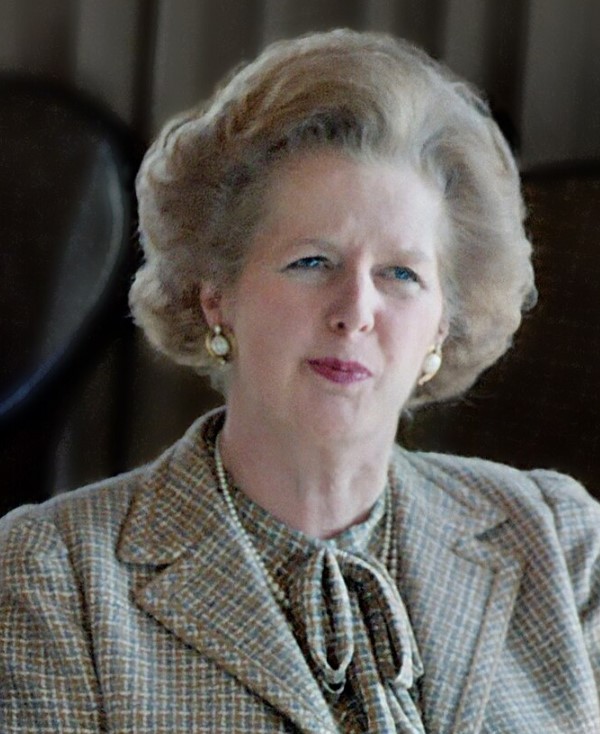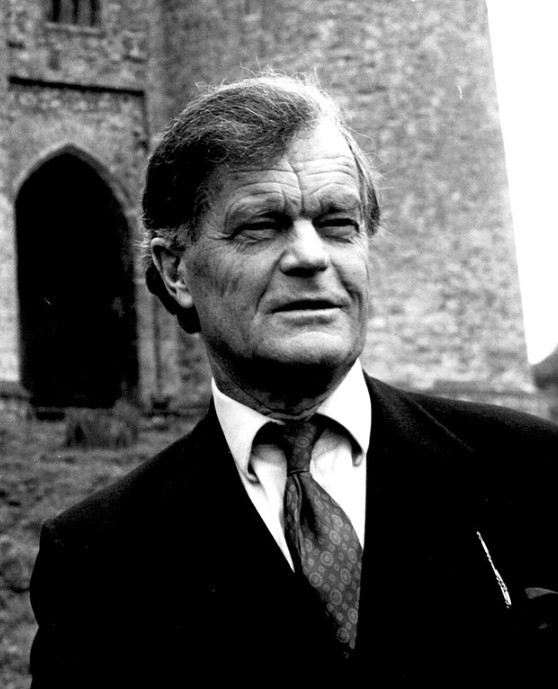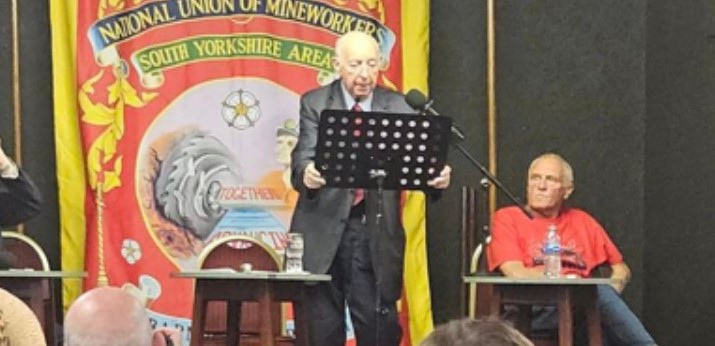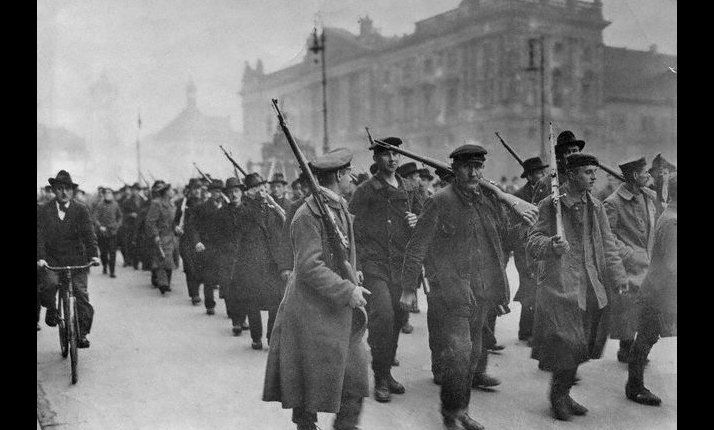Continuing our occasional series on the great miners’ strike of 1984-85, we reproduce here a speech by the then NUM President, Arthur Scargill, which he made at Goldthorpe Colliery on 29th June, 2024. Scargill’s speech reveals, among other things, that a threatened strike by the National Association of Colliery Overmen, Deputies and Shotfirers (NACODS) almost caused Thatcher to cave in, but for some still unknown reason, despite its 82% mandate, that union called off its strike.
………………………..
Today I’m here to honour miners and their families who in 1984/58 fought the greatest workers’ fight since the days of the Merthyr Rising (1831), the Tolpuddle Martyrs (1834), the Newport Chartists (1839), the Featherstone Martyrs (1893) and the Suffragettes (1903).
I honour, as I always have, the young miners fighting for the future – and the magnificent Women Against Pit Closures who for a year were at the forefront of our struggle to save pits, jobs and mining communities.
It is time that all members of our Union, our supporters and indeed the general public become aware of certain important facts about our historic struggle.
During early Summer 1982, in the first months of my NUM Presidency I was told – obviously in great confidence – by the National Coal Board’s Director of Public Relations, Geoff Kirk, that the NCB and the Tory Government intended to launch a pit closure programme in the Autumn of 1982.
Pit closure attacks were looming
On the basis of our Union’s experience and without betraying the source of my information, I warned that a pit closure attack on our industry was looming. On the evening of 1st November 1982, Don Loney, the NUM CEO, came to my office with a sealed package. He said it had been given to him by John Mills, the NCB Deputy Chairman, to hand to me privately. I opened it and read it.
The following morning, 2nd November, I reported to a meeting of the NUM National Executive Committee that I had been handed documents which showed that the Coal Board intended:
A. To close 30 pits which were described as uneconomic, and according to the Board accounted for operating losses exceeding £200 million; and
B. To close 75 short-life collieries (including Coegnant in South Wales, which had already been closed).
There was a NOTE: included in the list of short-life collieries were 10 of the “uneconomic” pits referred to in “A” above. The total number of threatened pits was 95.
In presenting this information to the NEC, I pointed out that these documents were dated March 1982, eight months earlier, at a time when the Board had been denying that there was any “hit list” or closure plan.
The NEC was of course shocked and angry and agreed to demand that the Board supply ALL documents relating to pit closures, including naming each individual threatened pit.
None of the information we asked for was supplied.
The evidence I’d been given didn’t surprise me. Alongside the Government’s memories of defeat by the 1969, 1972, 1974 and 1981 miners’ strikes, the Tories had experienced a stunning defeat, particularly in 1981, when NUM members had taken strike action – without NEC permission or a ballot or a Conference – against pit closures which had forced the Government in 1981 into a humiliating settlement.
Special delegate conference in October 1983
The Union was now warning that an attack on our industry was coming and preparing for a fight-back. The NEC agreed to call a Special National Delegate Conference to determine the NUM’s response.

On 21 October 1983, we held the Delegate Conference which voted unanimously for a national full overtime ban. Over the next four months the ban had an extraordinary impact. It cut national coal stocks to about the same level as they had been during the successful – and unofficial – miners’ strike in 1981.
On 1st March 1984, following discussion with the Government, National Coal Board Directors in four Areas announced the immediate closure of five pits: Cortonwood and Bulcliffe Wood in Yorkshire, Herrington in Durham, Snowdown in Kent and Polmaise in Scotland. This action was in breach of the procedures which had applied from 1947 and the Plan for Coal signed in 1974 and confirmed by the Tory Government in 1981.
At a National Executive Committee meeting on 8th March 1984, one week later, Scotland and Yorkshire sought endorsement from the NEC for strike action in their Areas. They were given authorisation in accordance with National Rule 41, and the NEC confirmed that any Area could if they wished take the same decision. On 12th March 1984, Area pit closures were correctly dealt with by NUM Areas in accordance with Rule 41 and strike action began.
I’m fed up of our critics saying we “picked the wrong time of year” for a strike. Our fight-back started in November 1983 – an appropriate time for miners to start industrial action.
At a Special Delegate Conference on 19th April 1984, delegates rejected a call for a national strike ballot and voted to support and strengthen the 180,000, or 80%, of Britain’s miners who were already on Area strikes in accordance with National Rule 41. Pits were being threatened on an Area basis and miners were taking strike action similarly on an Area basis.
I was convinced that steel and coking plants were the key
From the start, I was convinced that the steel industry and coking plants should be the Areas’ main picketing target – far more than power stations or, indeed, the pits in the few Areas that had rejected strike action.
On the basis of information I had in 1984, I argued with Leaders of Areas on strike that the obvious targets were the steel plants at Scunthorpe in Lincolnshire, Ravenscraig in Scotland and Port Talbot in South Wales – and the coking plants which supplied them. For that reason I saw the Orgreave coking plant in South Yorkshire as a crucial target for picketing.
My argument was initially rejected by Area leaders, who believed that the main targets should be those Areas which had not joined the Strike and who started picketing in Areas which had opposed Area strikes.
It was not until May 1984 that my view on Orgreave was accepted.
I’m fed up with reading and listening to historians and media experts who say that miners “walked into a police trap” at Orgreave on 18th June. It’s untrue.
Picketing started at Orgreave on 23rd May, and by the 27th thousands of miners – and supporters – were responding to the call for mass picketing at this coking plant which supplied the coke essential for the giant Scunthorpe steelworks.
Of course, police numbers grew accordingly. By 30th May, the growing number of pickets had led to a substantial number of us being arrested, including me.
We had publicly urged our members to join on the 18th of June. On the day, 10,000 pickets had arrived by early morning. We knew the police would turn out in greater numbers than before. How did I know? I had been shown a Government Order by George Moores, a South Yorkshire County Councillor responsible for the South Yorkshire Police and I knew that 8,200 had been deployed to Orgreave.
We were there at Orgreave with a strategy
But we were there for a reason – and with a strategy. We did not “walk into a trap”. We had worked out how to co-ordinate our actions. 6,000 had been deployed on the high ground on the top side of the plant near to Orgreave Village, and 4,000 to the low side below the plant entrance so that we had the police between our pickets.
From a little shop in Sheffield, I had purchased six walkie-talkies for distribution among picket leaders – including Jack Taylor, Sam Thompson, Dave Douglass and our NUM “film crew”. As a result, our lines of communication held through the early part of the day.
What we faced were police in full riot gear with long shields, short shields, truncheons – and dogs. There were visored police on horseback, carrying long staves which they swung to hit our pickets – miners in T-shirts.
It has long been admitted that the police brutality at Orgreave on 18th June 1984 was a deliberate tactic used by the State to wage war against the National Union of Mineworkers. At least 123 pickets were injured; a number had to be hospitalised (including me). 95 – including some of those worst injured – were arrested and charged with riot, unlawful assembly and violent disorder. These charges were discredited and dropped with the acquittal of those who were put on trial.
What is virtually never reported is that before the end of that day, 18th June 1984, the police were forced to close the plant in accordance with a telex from the British Steel Chairman Sir Robert Haslam, who was horrified by the police brutality screened for all to see. A copy of that telex was handed to me by BBC Correspondent Nicholas Jones and the closure of the plant is referred to by Dave Douglass in his book “Ghost Dancers”, whilst Denis Doody, a Yorkshire miner and later a UCATT Official, recalls hearing news of the closure on Sheffield Radio.
The tragedy was that the pickets were withdrawn the next day. From my hospital bed I had urged Area leaders to step up the picketing on the following day 19th June, to increase the pressure, as we had at Saltley in 1972.
Had that happened, I have no doubt that Orgreave would have been closed and Scunthorpe would have faced immediate closure. The impact of that, and the effect elsewhere would have forced the Government to settle the strike. Nine years after the strike, my argument that picketing steel works and coking plants was crucial and the Government’s weakest point was confirmed by none other than Margaret Thatcher.
Margaret Thatcher’s memoirs very revealing
In a 40-page chapter titled “Mr Scargill’s Insurrection” in her 1993 autobiography, she wrote of her concern in March 1984 that steel could be hit by our strike action. She wrote: “The CEGB estimated endurance [as at March 1984] at about six months but this assumed a build-up to maximum oilburn – that is, using oil-fired stations at full capacity – which had not yet begun.
“We had to judge when this should be set in train because it would certainly be described as provocative by the NUM leadership.
“We held off while there seemed a prospect that NUM moderates might force a ballot. However, I decided on Monday 26 March that this nettle must now be grasped.”
She went on to write, “Industrial stocks were, of course, much lower than those at the power stations: the cement industry was particularly vulnerable and important.
“But it was BSC whose problems were most immediate. Their integrated steel plants at Redcar and Scunthorpe would have to close in the next fortnight if supplies of coke and coal were not delivered and unloaded. Port Talbot, Ravenscraig and Llanwern had stocks sufficient for no more than three to five weeks. Not surprisingly, BSC was extremely concerned as the position changed from day to day”.
This was the state of Government uncertainty as NUM Areas ended the first month of the strike. These were Thatcher’s fears from the beginning about stocks at steel works, Redcar, Scunthorpe, Ravenscraig, Port Talbot and Llanwern, and coking plants such as Orgreave. Her autobiography from 1993 proves my main target had been correct.
“Refusal to negotiate”
For 40 years, I have been accused of refusing to negotiate a settlement with the NCB, and of “snatching defeat from the jaws of victory”. This was and is a lie. The NUM settled the strike with the NCB on five separate occasions in 1984: on 8 June, 8 July, 18 July, 10 September and 12 October – only to have the NCB renege on these settlements on what we now know was Government instruction.
The most important “settlement terms” were agreed between the leaders of the pit deputies’ union NACODS and the NUM in October 1984, at the offices of the conciliation service ACAS. NACODS had just conducted an individual ballot of its members and obtained an 82% vote for strike action.

Following the NACODS result, ACAS invited the NCB, NUM and NACODS in to see if there could be a negotiated settlement. After futile discussions with the NCB, I drafted a hand-written proposal in consultation with my two closest colleagues, Michael McGahey and Peter Heathfield. I then took it to the NACODS leadership who were in an upstairs room. My proposal read:
“That the NCB withdraw its pit closure plan, give an undertaking that the five collieries earmarked for immediate closure be kept open, and guarantee that no pit will be closed unless by joint agreement it was deemed to be exhausted or unsafe.” (The Union’s Press Officer took and kept a copy of this.)
Ian MacGregor, NCB chairman, walked out
This proposal was accepted by NACODS and acceptable to the conciliation service ACAS. It was then submitted to the NCB. It was emphasised that if the NCB did not accept this joint proposal, the NACODS strike would go ahead. In response, NCB Chairman, Ian MacGregor, and his team walked out of the ACAS offices.
Further reconvened discussions were planned. But on the eve of those reconvened discussions I learned that the NACODS leadership had inexplicably reneged on its agreement with the NUM and had instead reached an agreement with the NCB for an amended colliery review procedure. My NUM colleagues then, including those who are here today, know how useless that “amended” review procedure turned out to be.
What made the situation even more incredible was that the TUC negotiating team of Norman Willis, Ray Buckton and David Basnett had pleaded with the NACODS leaders to stick to the agreement they had reached with the NUM at ACAS and go ahead with their strike! Whoever heard of the TUC doing that?!
No explanation has ever been given by NACODS for this U-turn, or sell-out, which had terrible historical consequences, leading as it did to the destruction of Britain’s deep-coal-mining industry. I was to discover eight years later some information which makes the mystery even deeper.
On 17th July 1992, I took part in a Channel 4 programme called “Stab in the Dark”. Its presenters were David Baddiel, Michael Gove and Tracey MacLeod, and the guests were Labour MP Kate Hoey, Alan Clark MP (a former Government Minister), and me.
Tory MP, Alan Clark, asks a pertinent question
When the programme finished, Tracey MacLeod, who had interviewed me, took me into the Green Room where Alan Clark was sitting with Michael Gove; we sat at a nearby table. After a short while, Alan Clark suddenly rose and moved over to sit next to me and Tracey MacLeod and said: “Arthur! I’d like to ask you a question!”
“What about?” I replied.
He said: “I’ve never understood why, when the Colliery Under-Managers called off their strike….” I interrupted him: “I think you mean the National Association of Colliery Overmen, Deputies and Shotfirers, NACODS?”
“Yes!” he said; “That’s the one. In October 1994, Margaret convened a special meeting of the Emergency Committee at which she said in light of the Deputies’ Union voting to take strike action along with the NUM we had no alternative but to conclude a settlement in line with what NACODS had agreed with the NUM at ACAS. She said we could present this as a settlement in which ACAS played the important part”.
“Three days later”, Clark said, ”Margaret reconvened the Emergency Committee and said: ‘Panic over – we’ve arranged with NACODS and the NCB to accept an amended colliery review procedure and they’ve agreed to call off their strike when they meet again at ACAS’”.
Alan Clark went on to say that he’d never been able to understand why, when the strike had been effectively won by the NUM, NACODS called off its strike. I replied: “I take the same view”.
I’ve no idea whether either Tracey MacLeod or Michael Gove were listening into my conversation with Alan Clark, but both were close enough to have done so. I was scribbling notes as he talked to me and after leaving the studio and within an hour I was dictating my record of the conversation to the Union’s Press Officer.
The NACODS decision in October 1984 has remained a mystery.
Sabotage on the left
Throughout the strike, the NUM’s National leadership was under constant attack – from the Government, the NCB, the Confederation of British Industry, the Institute of Directors and of course television, radio and the press.
Tragically, though, as I discovered by the Summer of 1984, our fight to save pits, jobs and communities was being sabotaged by an unexpected source – the Communist Party of Great Britain, or elements within that Party.
The CP’s Industrial Organiser was Pete Carter. I began to learn from CP NUM activists that Carter was going round the coalfields holding meetings at which he urged our CP NUM members to campaign to call off the strike action, return to work and “normality” without a settlement: giving up our fight for the future. This was very close to the political line being pushed by politicians such as Labour Party Leader, Neil Kinnock.
I was furious and demanded to see Carter and Communist Party General Secretary Gordon McLennan, together with Mick McGahey, who was not only NUM Vice-President, but a leading CP member. We met in London’s County Hotel. The atmosphere was hostile.
I got straight to the point, demanding of Carter whether what I had heard from NUM members was true – was he touring the coalfields urging miners to campaign for an end to the strike without an agreement, abandoning our fight against pit closures?
Pete Carter said, straight out: “Yes”. He had been going round the coalfields with that message. Communist Party General Secretary Gordon McLennan’s initial response was that this was not the position of the Party; it was not CP policy. I found McLennan’s response difficult to accept. Mick McGahey, on the other hand, said forcefully that he knew nothing of it and it flew in the face of everything the NUM had been fighting for. McGahey appeared very angry.
Carter remained perfectly calm and unfazed by my bitterness and by the confusion of Gordon McLennan. This made me even more angry. When I asked how as a Communist he could be sabotaging workers’ struggle he simply said: “I think it’s the right policy”. At that point we nearly came to blows, but I just looked at him, said: “Fuck off”, got up and walked out of the County Hotel.
It’s impossible to gauge, 40 years on, the damage this sort of sabotage, seemingly sanctioned by the Communist Party of Great Britain, actually accomplished.
NACODS decision not to strike has remained a mystery
On 21st February 1985, we held a Special Delegate Conference at which the NEC called upon the trade union movement not to leave the NUM isolated. We called upon all our members to stand firm, and those not yet involved to support our Union against the Government’s attempt to destroy us. This was carried unanimously.
Inexplicably, by 28th February, just one week later, five NUM Areas asked for a recall Conference to agree an immediate return to work without a settlement. Like the decision of the NACODS leaders in October 1984, why those five NUM Areas called for a re-convened Conference within a week of voting to continue the strike has never been explained.
The recall Conference took place on 3rd March 1985. The NEC’s position was for continuation of the strike, as instructed by Conference less than a fortnight earlier. The resolution to call off the strike and return to work was proposed by the South Wales Area and seconded by the Durham Area. The vote to return to work was carried by 98 votes to 91.
The three National Officials – Mick McGahey, Peter Heathfield and myself – supported continuation of the strike. We had strong indications, later confirmed, that the Coal Board and Government could not have held out beyond July 1985, with 140,000 miners still on strike.
The miners’ strike of 1984/85 remains not only an inspiration for workers, but a reminder to today’s trade union leaders of their responsibility to their members, and the need to come together in direct action to challenge Government and employers against all forms of injustice, inequality and exploitation.
The real victory of that strike was and is the struggle itself.
It is a privilege to be here today with men and women who took strike action in 1984, their families and all who supported the NUM and supported the strike. You marched into history, and entered the pantheon of working class heroes and heroines.
I salute you.
Scargill’s speech was originally published by Socialist Labour Party, here.



